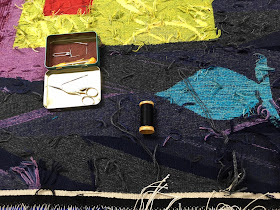But then there is . . . the dark side. If like me, you don't weave in your weft tails as you go, you have to deal with the hairy back and the warp ends of the tapestry somehow. You have to clip, tie, and/or tack down those tails so they're as unobtrusive as possible. You have to figure out hems and hanging solutions. Actually, I don't really mind this part, as the hand work allows me to spend quality time looking closely at the piece and thinking about it. What worked, what would I do differently next time, and what's next?
 |
| Molly Elkind, Red Letter Night, detail (reverse side), (c) 2018 |
I've been doing a lot of this finishing work lately, getting ready for a solo show that I hang--yikes--one week from today. It's been nine years since I last had a solo show, and I've forgotten how much non-studio work is involved. There's a whole 'nother "dark side" of the tapestry biz: Paperwork! Documentation! It's no fun, but you gotta do it. Here's the spreadsheet I made just to keep track of all the tasks.
Today I made labels to sew on the back of the work. You might think you'll never forget the details of each piece you've made, but trust me, you might. I weave my initials into my tapestries, but I also sew on a cotton label with the title, my signature, the year it was completed, and the materials used (useful if the piece needs to be cleaned or conserved in the future). I tack this label to the back of the piece (thank you, Rebecca Mezoff, for this model). If you enter your work in shows, this is essential documentation so that handlers always know whose piece it is.
For my exhibit, I'm putting much the same basic information on wall labels: title of the work, materials and, if applicable, price. Since I am the only artist in this show, I'm omitting my name from the wall labels this time.
 |
| Cutting wall labels printed on cardstock |
I also put together a binder with information about me. This binder will be out on a table near the guestbook at the gallery. In mine, I'm including my updated resume, my artist statement, and the checklist.
 |
| binder with checklist and information for potential buyers |
 |
| Mary tapestries inventory (not current) |
Why bother with documentation at all? That's the topic for my next post.


Thank you, Molly, for this helpful explanation of how you document your work. It inspires me to get busy on creating a similar system for keeping better track of my paintings, jewelry and accent mirrors. I've been researching software packages to help deal with this administrative chore because my DIY record keeping has been less than successful. If I could turn back the clock, I'd have established a good inventory system with the first sale of my work years ago. Now, 15 years later, trying to remember what a painting completed several years ago looked like, much less its title, dimensions and disposition, is all but impossible!
ReplyDeleteHi, Lynn, Thanks for reading! If I were you I wouldn’t try to remember the details of long-gone pieces, but just start by recording what you still have on hand. I break my inventory tables up into separate documents by type of work, or series—in your case, perhaps different tables or documents for paintings, jewelry, and mirrors. Makes it easier to find what you’re looking for.
ReplyDeleteMolly, thanks for sharing your documentation and labeling system. I’m in the fortunate position of being a relative newby, so the timing is great to adopt a similar process while the details of my first sale is still fresh in my memory.
ReplyDeleteSo glad you found this helpful, Marlena. Congrats on your sale! Make sure you add that buyer to your mailing list!
DeleteMolly, this was a great blog. When you give someone (gallery or collectory) a piece, do you wrap it in muslin? I'm considering making muslin bags for my pieces that are sold. Your thoughts? Carol Irving
ReplyDeleteHi Carol! I wrap my pieces in a thin protective foam envelope from Uline. These bags are great for framed pieces too. I forget the exact name of it but I’ll look if you want. A muslin bag sounds lovely too.
Delete